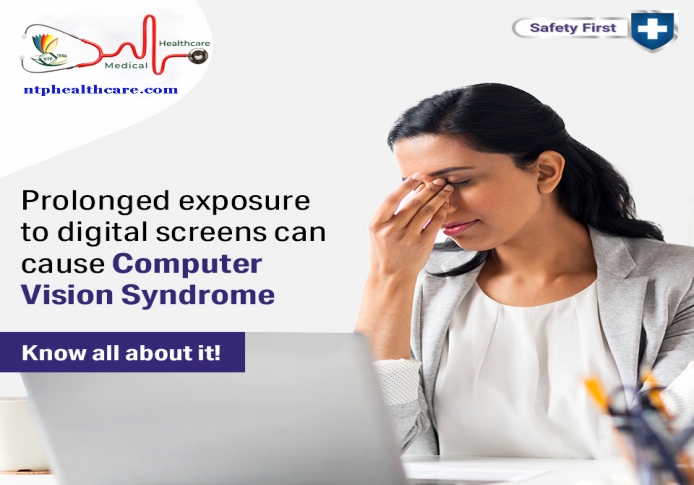Symptoms of Computer Vision Syndrome
What is Computer Vision Syndrome?
Computer Vision Syndrome or Digital Eye Strain refers to the problems caused by prolonged exposure to digital screens. This happens due to the high-energy light emitted by the screen. It has a high frequency of 400 to 500 nm in the visible spectrum.
What adds to the misery is the lack of adequate sleep. An uninterrupted sleep of seven to eight hours is important to recover strained eye muscles.
If you have symptoms of computer vision syndrome, contact us Today
Computer Vision Syndrome (Digital Eye Strain) Treatment at Centre for Sight
We offer end-to-end treatment for addressing computer vision syndrome including the detection, evaluation, and management along with a detailed assessment of the occupational environment of every individual before customizing the best possible treatment protocol for computer vision syndrome.
To begin with, our optometrist conducts a few tests for the patient suffering from computer vision syndrome.
Medical History
This helps in the understanding of any underlying health issues that may be linked with the current state of the patient.
Accurate measurement of visual acuity: tests help in determining the health of the eye and sets the tone for the rest of the examination.
Refraction test: Refraction tests help doctors to decide the management protocol, which may include recommendations about a reduction in computer and other screen usages.
Eye focus tests: Focusing tests are important to assess how well your eyes can focus, both near and far.
Computer Vision Syndrome Symptoms (Digital Eye Strain)
Eye pain
Headache
Blurred vision
Non-ocular issues such as neck and shoulder pain
Dryness of eyes
Irritation of eyes
Difficulty in changing focus, both near and far
Causes of Computer Vision Syndrome (CVS) / (Digital Eye Strain)
Do you spend more than two hours a day working on a computer? Do your eyes feel tired in the evening after working on a computer screen? Do you occasionally suffer from blurred vision or stiff neck and shoulder pains? If Yes, then like millions of others, you too may be suffering from computer vision syndrome (CVS) or computer eye syndrome.
Computer Vision Syndrome Causes
Decrease blink rate
Blinking is an important function that adds moisture to the eye surface and also helps in protecting the eyes from irritants. When you work on a computer, you tend to blink less than normal.
Visual problems
People having nearsightedness, farsightedness and astigmatism are more likely to develop computer vision syndrome.
Computer glare and reflection
Glare from shiny surfaces, light-colored painted walls, computer screens, and VDT workstations causes eye strain.
Non-ergonomic workstation
Improper workstation set-up also causes headaches, neck and upper back pain because you tend to tilt your head towards the back to watch the screen.
Improper ventilation
Improper ventilation systems cause discomfort and dryness. Air conditioners or heaters cause dryness in the air which contributes to dry eye, especially for those who wear contact lenses.
Computer Vision Syndrome Treatment Includes Some Lifestyle Changes
How Can I Avoid Computer Vision Syndrome or Computer Eye Syndrome?
Use adequate lighting
Computer vision syndrome (digital eye strain) can be avoided by putting shades and drapes on windows to avoid bright light coming from outside when you are working on a computer.
Adjust the brightness of your computer screen
Computer vision syndrome (computer eye syndrome) can be avoided by closely matching the brightness of the environment with that of your computer screen, by using the buttons on the monitor.
Reduce glare
An anti-glare screen on your monitor can help you in avoiding computer vision syndrome to a greater extent. An anti-reflective coating added to your eyeglasses prevents you from reflections and glare.
Take frequent breaks
As a part of digital eye strain treatment (computer vision syndrome treatment), avoid working on the computer screen for long hours. Close your eyes, get up for a glass of water, or chat with a colleague to relieve eye strain..
Follow the 20-20-20 rule
Take a 20-second break and look 20 feet away every 20 minutes. This exercise will help you prevent strained near vision and stretches your focusing muscles.
Exercise even when sitting
Digital eye strain treatment (computer vision syndrome treatment) will always have exercise as an integral part. Anyone in a sedentary job, especially those using computers, should stand up, move about, or exercise their arms, legs, back, neck, and shoulders frequently.
Using protective eyewear
People who continuously work on computer screens must consider the option of using customized computer glasses with a special coating. Computer glasses also are a good choice if you wear bifocals or progressive lenses, as these lenses are not optimal for the distance to your computer screen.
Get regular eye check-ups
To ensure that your eyes stay healthy and fresh, remember to get regular eye check-ups done so that any issues with your vision can be detected in its early stage. A lot of other health issues like computer vision syndrome (computer eye syndrome) can also be detected during a comprehensive eye test other than just problems with your eyes. While these measures will resolve digital eye syndrome, in many cases, it is recommended to visit an eye specialist for consultation whenever computer eye syndrome (computer vision syndrome) symptoms are observed.
Eye Exercises To Relieve Digital Eye Strain Or Computer Eye Syndrome
Do you spend more than two hours a day working on a computer? Do your eyes feel tired in the evening after working on a computer screen? Do you occasionally suffer from blurred vision or stiff neck and shoulder pains? If Yes, then like millions of others, you too may be suffering from computer vision syndrome (CVS) or computer eye syndrome.
Palming
Palming is one of the most relaxing exercises for relieving eye strain. This exercise requires you to rub your hands together for 10 to 15 seconds until they feel warm. After this, close your eyes & gently place your palms over the eyes, blocking out light completely. Now breathe deeply & relax.
Massaging the eyes, eyebrows & temples
Massaging your eyes, eyebrows & temples is a simple yet excellent exercise to get rid of eye strain. This exercise is proven to reduce eye strain by increasing the blood flow to these areas. The light pressure felt during these exercises increases moistness in the eyes, which provides relief to the tired eyes.
Blinking
Blinking can help a lot in treating computer vision syndrome. The normal blink rate of a human being is about 20 times per minute but it drops to 7 times per minute when using a computer or watching television. Blinking is very important when working on a computer as it moistens your eyes to prevent dry eye & irritation.
Eye roll
One of the exercises for computer vision syndrome treatment can be eye-rolling. You can deal with eye strain to some extent if you do eye-rolling at specific intervals. Sit up straight, keep your shoulders relaxed and slowly roll up your eyes to the sky. Keep staring at the sky for a while, and bring back your eyes to the ground slowly. Practice this eye exercise for at least 10 minutes; you will feel relieved from computer eye strain.
Zooming
One must do zooming exercises to beat digital eye strain (computer eye syndrome). For this, stand straight and hold your arm straight in front of you. Keep up your thumb and start focusing on it. Slowly bring back the thumb closer to your eyes and again concentrate on it. Repeat this exercise for 15 minutes.
Writing messages on the wall
This is also one of the exercises that you can practice to alleviate computer vision syndrome. Consider your eyes are lasers and pretend to use them to write something on the wall. Your eyes will move very fast with this exercise, resulting in increased stimulation.
Our eye specialists will also treat your dry eyes which is both cause & outcome of computer vision syndrome.
For treating dry eyes, they may suggest:
Artificial teardrops
Lenses to correct your vision
Drink plenty of water
Using a humidifier
Taking prescription medicine that will increase tear production
How to treat computer vision syndrome (computer eye syndrome) in children?
Technology has become an integral part of our lives. Hence, be it, adults or children, everyone has their reasons to remain glued to the digital devices. Adults spend uninterrupted long hours on screen because of work, while children use digital devices for entertainment, infotainment, etc. In the case of computer vision syndrome (Digital vision syndrome), prevention is better than cure. Therefore, if you notice computer vision syndrome or digital vision syndrome symptoms like redness in the eyes, stiff neck pain, and dry eyes, please take these precautionary measures:
Limit screen time
If children need a computer or any digital device for their school or other relevant work, barring that limit all possible screen time for them.
Stretch
Taking short breaks while you use the computer is always advised. Apart from that, it is equally important for your eye muscles to relax and focus at a distance while working on the computer. Stretching will help relieve muscle tension, thereby treating computer eye syndrome.
Spend time outdoors
It is essential to spend a few hours outdoors daily to relieve tension associated with computer vision syndrome (digital eye strain).
Rearrange your childs desk
One of the glaring reasons for computer vision syndrome (computer eye strain) is a non-ergonomic workstation. Watch out the settings of the desk, chair, lamp, lighting in the room, computer set-up, etc. Change settings, which is unsuitable for your childs sitting posture and giving him/her discomfort. A few tweaks in the settings can help them sit comfortably.
Explore FAQs
Is there any age limit for computer vision syndrome or digital eye strain?
Computer vision syndrome can happen to anyone. Nowadays, it is reported in children as well because they spend a lot of time on tablets, mobile phones, etc.
How can computer vision syndrome (computer eye strain) affect me in the future?
Computer vision syndrome or computer eye strain can affect in several ways. It can dramatically reduce your productivity, resulting in poor visual functions, dry eyes, an increase in errors at the workplace, etc.
Can computer vision syndrome or digital vision syndrome be prevented?
Yes, computer vision syndrome (digital vision syndrome) can be prevented with awareness. If you follow a healthy lifestyle and keep a watch on the time spent on computers or digital screens along with adequate sleep, this can prevent symptoms of computer vision syndrome.
If I do not have computer vision syndrome (digital vision syndrome), do I still need to wear computer eyewear?
Maybe. Wearing computer eyewear can prevent you from experiencing symptoms of computer vision syndrome or digital vision syndrome. A comprehensive eye examination followed by your eye specialist advice could be helpful.















